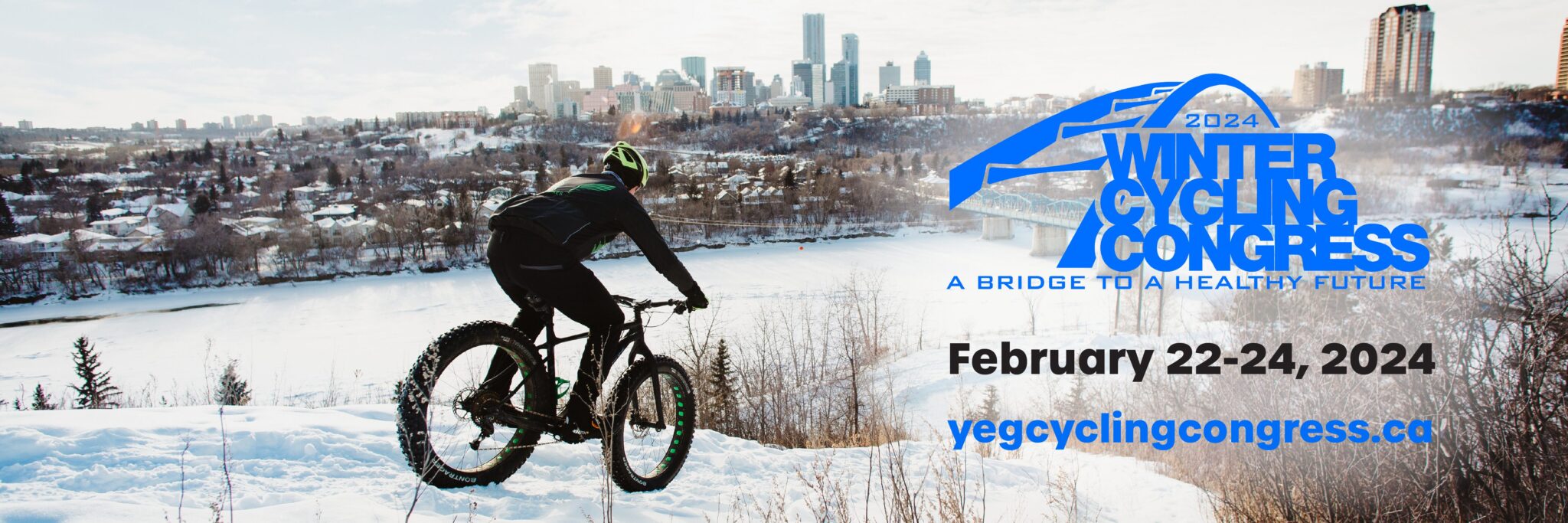WINTER CYCLING IN ALBERTA
Winter cycling may seem exotic and strange, but if you’ve ever biked in the warmer weather, or cross-country skied, snowshoed, or even walked outside in the winter, you’re 89.6% prepared to ride your bike in winter! How so, you might ask? Well:
- You already own the clothing.
- You know how to dress in layers so you don’t overheat.
- You probably don’t find the outdoors intimidating.
- You know how to ride a bike.
All those skills add up to the basic elements needed to effectively ride your bike in winter. What a win for Active Travel!
When to winter cycle
To cycle in the winter, you don’t need to commit to the Itidabike (a winter bike race between 350 and 1,000 miles.) You don’t even have to ride every day to work! You could go get some groceries or just go for a leisurely ride on a trail near you. There are plenty of opportunities to cycle in the winter at a level that feels comfortable for you!
Most winter cyclists pick their temperature cutoff, and that temperature could even fluctuate. Maybe you draw a line at -15, but then think, hm… -15 isn’t so bad, let’s see what -20 is like! Maybe you’ve been winter cycling for a year, and you commit to riding just a bit further into the shoulder season (aka “near-winter” or “almost spring”) than you did last year. If you get up and you don’t feel like riding, you can always try again another day.
How to dress for winter cycling
So, you already own the clothing and know how to dress in layers – let’s put that to use! When you’re cycling in the winter, you’ll sweat like crazy. It seems counter-intuitive, but it is quite a workout to bike in winter! You’ll need to take care to stay dry, as hanging about waiting for the light to change when you’re sweaty can be a bit chilly. Your hands, feet and face might also get cold. All these extremities are relatively still – hands on handlebars, feet on pedals, face… well, you get the picture. If there’s any wind, you may feel it at these points first. Cross-country ski gear is great to add to your stock of riding clothes. There are covers for your handlebars (called pogies or bar mitts) and booties for your feet, but if you still have plastic bags in your life, they work as well as wind barriers.
Bike accessories for winter cycling
You might want to change or add a few things to your bike! It gets dark quickly in the winter, so you’ll need lights on the front (white) and back (red) of your bike. You might want to change from slick summer tires to more knobby mountain-bike-type tires.
Things to practice
You might want to lower your seat a bit so you can easily put your feet down if you’re feeling out of control. It’s good to practice staying more upright in corners, and if you are super nervous about riding on ice, head out to your community hockey rink and give it a go there.
There’s a lot of information on the internet on how to ride in the cold. Keep in mind many of the links there are for places that do not have winters as chilly as the Canadian prairies, but if you have a moderate temperature limit, there’s a great deal of useful information you can glean! Be sure to also check out local resources (a few are linked below) – they typically have excellent staff with stellar knowledge and experience eager to help you discover the joy of winter cycling.
Edmonton Resources:
Calgary Resources:
Here’s the secret: It’s a LOT of fun to ride in winter. It’s super addictive! It clears your mind, moves your body and gets you outside. But don’t take it from me. Go find your ski gear and see for yourself!
Written by Karly Coleman, CanBike instructor, winter rider and CJSR bike traffic reporter
Winter Cycling Congress 2024 in Edmonton
If you’re interested in learning more about winter cycling, wanting to build a community, or are already a cold weather biking aficionado, check out the Winter Cycling Congress in Edmonton in February 2024! This will be an unforgettable multi-day event filled with informative sessions, bicycle excursions, and a community of passionate winter cyclists. Discover new possibilities while exploring the cycling-friendly city of Edmonton. Don’t miss out on this unique opportunity to connect with fellow enthusiasts and learn from experts in the field.




I am the President of EMBA, the Edmonton Mountain Bike Alliance, and have been following updates on your Congress since it was first announced. I understand that the focus of the conference is bicycle transportation, rather than recreational cycling. This is in line with the focus of the City of Edmonton’s “Bike” Plan which, as the renamed Bicycle Transportation Plan, also is focused on bicycle transportation, to the exclusion of recreational cycling. So the focus is not particularly surprising.
However, it is somewhat anachronistic that the preponderance of photos (including the one here on the Comments page) are of singletrack, recreational, fatbiking, yet no part of your program seems to acknowledge the existence, use or preservation of those trails or the role that recreational cycling plays in creating the space for acceptance of bicycle transportation. Frankly, this is a disappointment.
I see that your program does deal with one aspect of recreational cycling, with the tour of the new INDOOR velodrome, but this seems to me to be less connected to “winter cycling” than fatbiking (again, as evidenced by the various photos).
If this becomes a more frequent event, please consider giving some thought to how recreational cycling connects to bicycle transportation. I attended one of the very early sessions on the Bike Plan facilitated by Katie Soles (who is one of your speakers) and believe that I was the person who suggested that the idea of “fun” was something that needed to be a fundamental part of the plan. Kids get into cycling because it’s fun; they don’t start riding their bikes for transportation. The number of people who participate in recreational cycling (mountain biking, fat biking, BMX, road, track, cyclocross, and both on organized levels and as casual enthusiasts) far outnumbers the group of people that regularly use a bike for transportation. But being a recreational cyclist makes it much more likely that you will use a bike for transportation. I know this from my personal experience, as I have been a summer cycling commuter for over a decade now.
A more holistic perspective on the cycling community would be appreciated. And, moving from the “winter” focus of your conference, I think the value of Edmonton’s singletrack trail network, and the City administration’s still tenuous acceptance of that singletrack network as something that contributes very significantly to our quality of life, would merit at least passing acknowledgment.
Your conference should be a great opportunity to not only highlight the quality of life and tourism value of the River Valley Alliance’s paved multi-use path network, but also to highlight the singletrack trail network (for both summer and winter recreational cycling), which is one of the most extensive networks in North America.
I hope that I am not coming across as (too much(!) of) a scold. I admire the effort you have gone to, to organize this event and to bring people here to discuss an important topic. I hope it will be a great success! The point I hope you will take from my comments is that I believe that paying some attention to recreational winter cycling (beyond including pictures of this activity) would be beneficial, and likely appreciated by your conference attendees.
Again, best wishes for a successful conference.